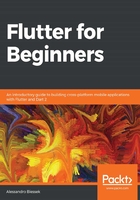
上QQ阅读APP看书,第一时间看更新
The evolution of Dart
Unveiled in 2011, Dart has been evolving ever since. Dart saw its stable release in 2013 with major changes included in the release of Dart 2.0 toward the end of 2018:
- It was focused on web development in its conception, with the main aim of replacing JavaScript: However, now Dart is focused on mobile development areas as well as on Flutter.
- It tried solving JavaScript's problems: JavaScript doesn't provide the robustness that many consolidated languages do, so Dart wanted to bring a mature successor to JavaScript.
- It offers the best performance and better tools for large-scale projects: Dart has modern and stable tooling provided by IDE plugins. It's been designed to get the best possible performance while keeping the feel of a dynamic language.
- It is molded to be robust and flexible: By keeping the type annotations optional and adding OOP features, Dart balances the two worlds of flexibility and robustness.
Dart is a great modern cross-platform, general-purpose language that continually improves its features, making it more mature and flexible. That's why the Flutter framework team chose the Dart language to work with.